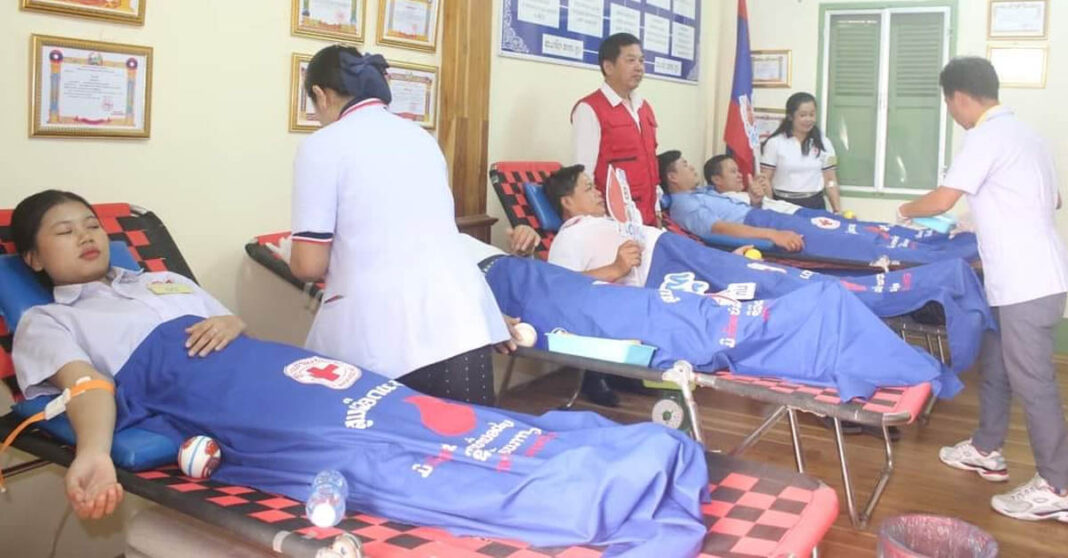With International Blood Donation Day approaching, Laos is preparing for an increase in blood donations.
Tomorrow, 14 June, the country will commemorate World Blood Donor Day by organizing several events across all provinces to increase awareness and collect blood donations. Vientiane and Luang Prabang provinces will be the main hubs for blood donation activities. This day marks an opportunity for local hospitals and clinics to educate the public on requirements and guidelines for blood donation amidst an ongoing shortage of blood stocks throughout the year.
In 2023, the National Blood Transfusion Center, operated by the Lao Red Cross, dispatched an average of 80 bags of blood daily, accumulating a total of 73,023 bags from approximately 57,000 donors. These donations, primarily sourced from secondary school students, army personnel, police, and government officials, were vital for surgeries involving road accident victims, among other emergency cases, according to Chanthala Souksakhone, the Director of the National Blood Transfusion Center in a meeting last month.
Chanthala further noted that the rapid increase in accidents across the country has made it difficult to accurately assess the amount of blood required by the Centre to ensure an adequate supply to hospitals.
Luang Prabang province mirrors this national challenge, facing a constant severe blood shortage. Dr. Anousin “Sin” Phonedala, Laboratory Manager at Lao Friends Hospital for Children in Luang Prabang, disclosed that the current blood supply is inadequate for the province’s population of 467,157, according to the 2020 census.
Luang Prabang receives approximately 4,300-4,500 blood bags annually from the provincial Lao Red Cross National Blood Transfusion Center, which organizes blood donations across the province.
Despite this, Anousin considers the supply insufficient, noting that more than 2,000 bags are used for children alone. To meet demand, the province needs at least 7,000 to 8,000 bags, especially with the increasing number of road accidents contributing to the rising need for blood.
“The issue is that many people do not meet the requirements to donate blood,” he explained. Target groups for donations include workers in hotels, restaurants, factories, and students, but only those aged 17 and above can donate.
Men can donate until age 60, and women until 55. The 2020 census indicates a potential donor pool of less than 290,000 people aged 15-64 years.
However, he noted that while numerous students are interested in donating blood, many of them are below the age requirement, and even among those who are 17 or above, fear and nervousness about the process deter participation.
On the other hand, a large part of the adult population is unable to donate blood due to permanent health issues. Anousin explained that illnesses such as high blood pressure, cancer, kidney infection, diabetes, and heart disease render individuals ineligible to donate blood.
In addition to the primary target groups, Sin pointed out that a significant portion of the rural population lacks awareness about blood donation and their eligibility to donate.
“Only a few people are aware of blood donation, mostly through word of mouth,” he remarked. Sin also mentioned that the blood transfusion center endeavors to educate rural residents about blood donation by conducting visits a few times a year.
“The results are merely acceptable. There are only a few occasions where we obtain the desired amount of blood,” he further noted.
Dispel Myths, Encourage Action
Fear and misconceptions about blood donation are major obstacles. “Many people still mistakenly believe that donating blood will cause them to experience dizziness, loss of appetite, and trouble sleeping. Some also have a fear of needles and blood.”
Anousin confirmed that these claims are unfounded, stating that there are no adverse side effects of blood donation.
To educate the public, the provincial Lao Red Cross, along with hospitals in Luang Prabang, has been conducting awareness-raising activities and campaigns at hospitals, hotels, and schools. These efforts aim to address the blood shortage problem and dispel misunderstandings about blood donation.
“We are trying to educate people with the basic knowledge they need to know before donating blood,” said the doctor. “This includes simple guidelines like avoiding alcohol for at least 18-24 hours before donating, getting at least 6 hours of sleep, and stopping the use of certain medications. Additionally, individuals with lung or reproductive diseases are considered ineligible to donate.”
The expert emphasized that all health professionals involved in the blood extraction process are highly skilled and specialized. He reassured residents that there is no cause for concern, saying, “Given that our bodies contain approximately four to six liters of blood, we extract only 520 milliliters or less from donors, a safe amount equivalent to about 13 percent of one’s total blood volume.”
He also encouraged those who may still have doubts to consider blood donation as a way to “save lives” by helping those in need. He explained that donated blood can be used to treat various illnesses, aid accident victims who have lost significant blood, and support women who have experienced massive blood loss during childbirth.



